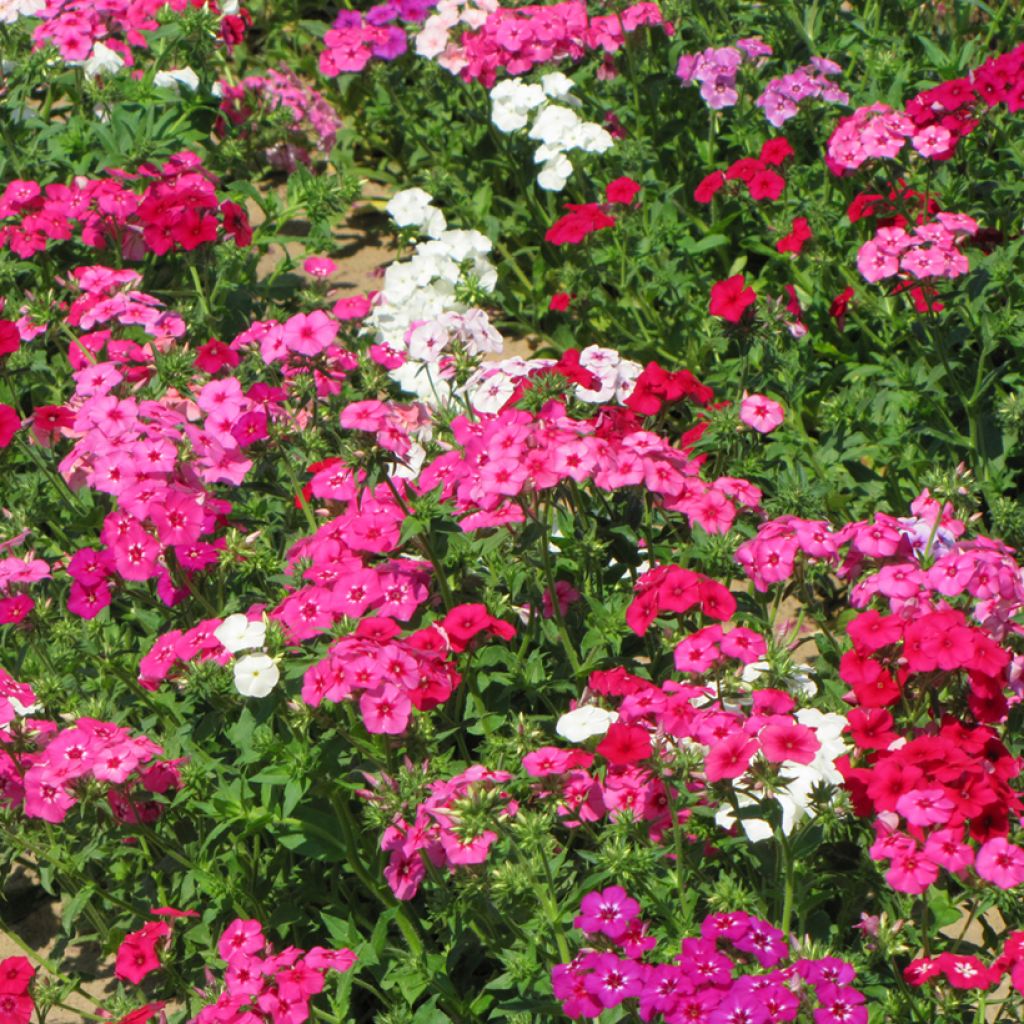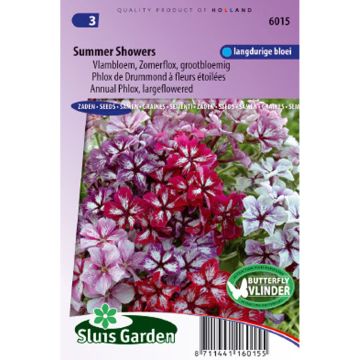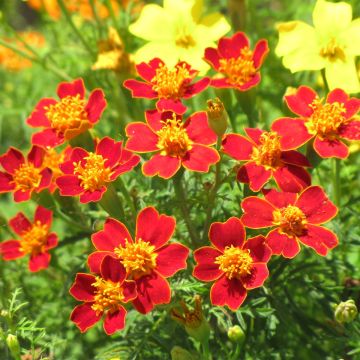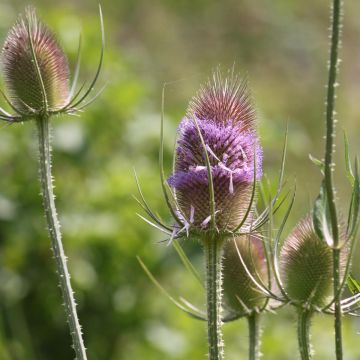

Phlox drummondii Grandiflora Mix seeds - Annual phlox
Phlox drummondii Grandiflora Mix seeds - Annual phlox
Phlox drummondii Grandiflora Mix
Annual Phlox, Drummond Phlox
This item cannot be shipped to the selected country
Delivery charge from €5.90
More information
Schedule delivery date,
and select date in basket
This plant carries a 6 months recovery warranty
More information
We guarantee the quality of our plants for a full growing cycle, and will replace at our expense any plant that fails to recover under normal climatic and planting conditions.
From €5.90 for pickup delivery and €6.90 for home delivery
Express home delivery from €8.90.
Does this plant fit my garden?
Set up your Plantfit profile →
Description
Phlox drummondii 'Grandiflora Mix' is a blend of annual phlox that enhances borders, edges, and containers for a good part of the summer. This selection captivates with its abundant, large, diversely coloured flowers, ranging from white to red, passing through various shades of pink and mauve. You can pick them to create lovely romantic or country-style bouquets.
Phlox drummondii belongs to the Polemoniaceae family. It is an annual plant native to the southern United States, particularly Texas. It is widely cultivated for its ornamental appeal. 'Grandiflora Mix' is a horticultural selection that brings together different cultivars with large, diversely coloured flowers. Each plant, with an upright and branched habit, reaches a height of 30 to 60 cm with a spread of 20 to 30 cm. Its foliage consists of lanceolate, narrow dark green leaves, while its stems are slender and slightly hairy. Flowering occurs from June-July to late summer, depending on the sowing date. It presents star-shaped, 2.5 to 3 cm diameter flowers. These often lightly scented flowers come in a wide range of colours: pure white, light pink, bright pink, fuchsia red, lavender, white with a dark pink eye. The flowers are clustered at the top of the stems, giving an impression of profusion. They attract bees and butterflies that pollinate them. The small dark seeds sow and reseed very easily.
Easy to grow in a pot on a terrace, these annual phlox will bloom more abundantly in the sun than in partial shade. The soil should be moist, well-drained and quite fertile, regardless of its pH, neutral, calcareous, or slightly acidic.
The 'Grandiflora Mix' Phlox are also interesting for adding colour to flower beds, creating beautiful flowering containers and lovely bouquets. This mix can be combined with cosmos, love-in-a-mist, and dwarf snapdragons 'Twinny Appleblossom'. Varieties such as Phlox drummondii 'Moody Blues', 'Blushing Bride', or 'Starry Eyes' are particularly suited to accompany other summer flowers in gardens or containers.
Report an error about the product description
Flowering
Foliage
Plant habit
Botanical data
Phlox
drummondii
Grandiflora Mix
Polemoniaceae
Annual Phlox, Drummond Phlox
Cultivar or hybrid
Other Phlox seeds
Planting and care
Phlox Drummondii 'Grandiflora Mix' are preferably sown under cover in a seed tray from February-March. Ideally, a temperature of 18-20°C should be maintained for rapid germination, but the seeds can germinate as soon as temperatures range between 13 and 15°C.
Just cover the seeds with a thin layer of potting soil (1 to 2 mm) kept slightly moist and place in the sun (essential for germination). They will sprout between 10 and 21 days. When the young plants are large enough to be moved, and the frost period is over, you can plant them out. Choose well-drained soil, if possible rich and sunny.
Sometimes not tolerating transplanting very well, it is also possible to sow them directly in place from April to May, after loosening the soil surface. Place one seed every 10/15 cm.
Cultivation:
Drummond Phlox prefer light, fertile, moist, well-drained soils and a sunny exposure. They are susceptible to powdery mildew, so you can carry out preventive treatment and make sure not to water the foliage. Protect young plants from slug attacks.
Sowing period
Intended location
This item has not been reviewed yet - be the first to leave a review about it.
Flower seeds
Haven't found what you were looking for?
Hardiness is the lowest winter temperature a plant can endure without suffering serious damage or even dying. However, hardiness is affected by location (a sheltered area, such as a patio), protection (winter cover) and soil type (hardiness is improved by well-drained soil).

Photo Sharing Terms & Conditions
In order to encourage gardeners to interact and share their experiences, Promesse de fleurs offers various media enabling content to be uploaded onto its Site - in particular via the ‘Photo sharing’ module.
The User agrees to refrain from:
- Posting any content that is illegal, prejudicial, insulting, racist, inciteful to hatred, revisionist, contrary to public decency, that infringes on privacy or on the privacy rights of third parties, in particular the publicity rights of persons and goods, intellectual property rights, or the right to privacy.
- Submitting content on behalf of a third party;
- Impersonate the identity of a third party and/or publish any personal information about a third party;
In general, the User undertakes to refrain from any unethical behaviour.
All Content (in particular text, comments, files, images, photos, videos, creative works, etc.), which may be subject to property or intellectual property rights, image or other private rights, shall remain the property of the User, subject to the limited rights granted by the terms of the licence granted by Promesse de fleurs as stated below. Users are at liberty to publish or not to publish such Content on the Site, notably via the ‘Photo Sharing’ facility, and accept that this Content shall be made public and freely accessible, notably on the Internet.
Users further acknowledge, undertake to have ,and guarantee that they hold all necessary rights and permissions to publish such material on the Site, in particular with regard to the legislation in force pertaining to any privacy, property, intellectual property, image, or contractual rights, or rights of any other nature. By publishing such Content on the Site, Users acknowledge accepting full liability as publishers of the Content within the meaning of the law, and grant Promesse de fleurs, free of charge, an inclusive, worldwide licence for the said Content for the entire duration of its publication, including all reproduction, representation, up/downloading, displaying, performing, transmission, and storage rights.
Users also grant permission for their name to be linked to the Content and accept that this link may not always be made available.
By engaging in posting material, Users consent to their Content becoming automatically accessible on the Internet, in particular on other sites and/or blogs and/or web pages of the Promesse de fleurs site, including in particular social pages and the Promesse de fleurs catalogue.
Users may secure the removal of entrusted content free of charge by issuing a simple request via our contact form.
The flowering period indicated on our website applies to countries and regions located in USDA zone 8 (France, the United Kingdom, Ireland, the Netherlands, etc.)
It will vary according to where you live:
- In zones 9 to 10 (Italy, Spain, Greece, etc.), flowering will occur about 2 to 4 weeks earlier.
- In zones 6 to 7 (Germany, Poland, Slovenia, and lower mountainous regions), flowering will be delayed by 2 to 3 weeks.
- In zone 5 (Central Europe, Scandinavia), blooming will be delayed by 3 to 5 weeks.
In temperate climates, pruning of spring-flowering shrubs (forsythia, spireas, etc.) should be done just after flowering.
Pruning of summer-flowering shrubs (Indian Lilac, Perovskia, etc.) can be done in winter or spring.
In cold regions as well as with frost-sensitive plants, avoid pruning too early when severe frosts may still occur.
The planting period indicated on our website applies to countries and regions located in USDA zone 8 (France, United Kingdom, Ireland, Netherlands).
It will vary according to where you live:
- In Mediterranean zones (Marseille, Madrid, Milan, etc.), autumn and winter are the best planting periods.
- In continental zones (Strasbourg, Munich, Vienna, etc.), delay planting by 2 to 3 weeks in spring and bring it forward by 2 to 4 weeks in autumn.
- In mountainous regions (the Alps, Pyrenees, Carpathians, etc.), it is best to plant in late spring (May-June) or late summer (August-September).
The harvesting period indicated on our website applies to countries and regions in USDA zone 8 (France, England, Ireland, the Netherlands).
In colder areas (Scandinavia, Poland, Austria...) fruit and vegetable harvests are likely to be delayed by 3-4 weeks.
In warmer areas (Italy, Spain, Greece, etc.), harvesting will probably take place earlier, depending on weather conditions.
The sowing periods indicated on our website apply to countries and regions within USDA Zone 8 (France, UK, Ireland, Netherlands).
In colder areas (Scandinavia, Poland, Austria...), delay any outdoor sowing by 3-4 weeks, or sow under glass.
In warmer climes (Italy, Spain, Greece, etc.), bring outdoor sowing forward by a few weeks.



















































